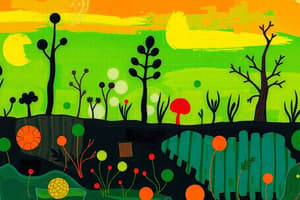Podcast
Questions and Answers
Where is carbon stored?
Where is carbon stored?
In various ecosystems such as soil, vegetation, and atmospheric forms.
How is carbon transferred from one store to another?
How is carbon transferred from one store to another?
Through processes such as photosynthesis, respiration, decomposition, and chemical weathering of rocks.
What is the aim of describing vegetative successions in the carbon cycle?
What is the aim of describing vegetative successions in the carbon cycle?
To explain the transfers of carbon through a vegetation succession.
What are pioneer species?
What are pioneer species?
The final sere (stage) is known as __________.
The final sere (stage) is known as __________.
What is the climatic climax vegetation in the UK?
What is the climatic climax vegetation in the UK?
What happens to lichen in the biotic conditions during succession?
What happens to lichen in the biotic conditions during succession?
How does carbon storage change as a hydrosere develops?
How does carbon storage change as a hydrosere develops?
Flashcards are hidden until you start studying
Study Notes
Vegetation Succession
- Succession: The gradual process of change in an ecosystem over time, leading from a simple community to a complex one. It involves changes in species composition and habitat.
- Seral Stages: Each step in the succession process is called a seral stage.
- Lithosere: A succession that begins on bare rock, a specific type of succession.
- Abiotic Conditions: The non-living factors affecting an ecosystem, such as weathering of rock, which releases carbon dioxide (CO2).
- Biotic Conditions: The living factors affecting an ecosystem, such as the growth of lichen, which helps to break down rock and create soil.
- Pioneer Species: The first species to colonize a barren area, like moss in a lithosere, which photosynthesize to store carbon and release oxygen (O2).
- Carbon Transfer: The process of carbon moving from one store to another.
- Humus: Decomposed organic matter in soil, helping to store carbon.
- Decomposition: The breakdown of organic matter by microorganisms, releasing carbon dioxide (CO2) back into the atmosphere.
- Carbon Storage: The amount of carbon held within an ecosystem or a component of it, such as in soil or vegetation.
Carbon Storage in Succession
- As a lithosere progresses, larger plants grow, leading to more photosynthesis and respiration.
- The decomposition of dead plants and animals creates humus, leading to increased carbon storage in the pedosphere (soil).
- The final seral stage, called the climatic climax, is a dynamic equilibrium where the balance of carbon inputs and outputs is equal on average.
Dynamic Equilibrium
- Dynamic Equilibrium: A state of balance in an ecosystem where inputs and outputs are equal on average, despite continual fluctuations.
- Climatic Climax: The final, stable community in a succession, determined by the climate of the region.
UK Climatic Climax
- The climatic climax vegetation in the UK is deciduous oak woodland.
Hydrosere
- Hydrosere: A succession that begins in water, typically in a lake or pond.
- Carbon Storage in Hydroseres: The amount of carbon stored changes over time as the hydrosere develops, with more carbon stored as larger plants and soil develop.
- Final Stage of Hydrosere: The final stage of a hydrosere is a terrestrial community, such as a woodland.
Studying That Suits You
Use AI to generate personalized quizzes and flashcards to suit your learning preferences.




